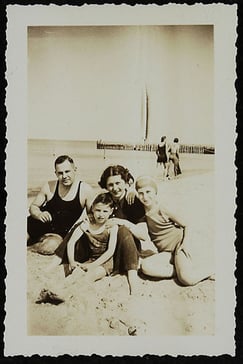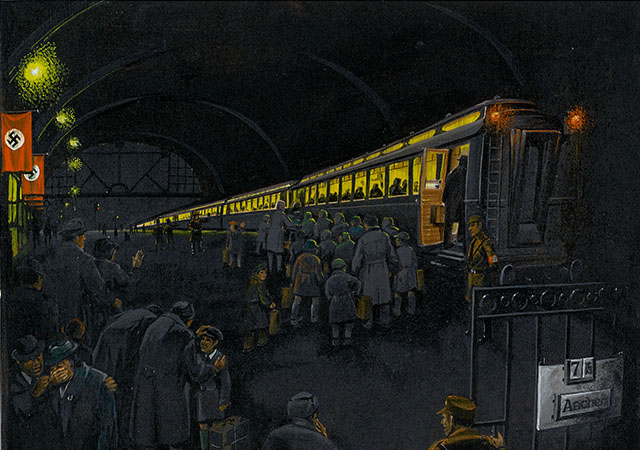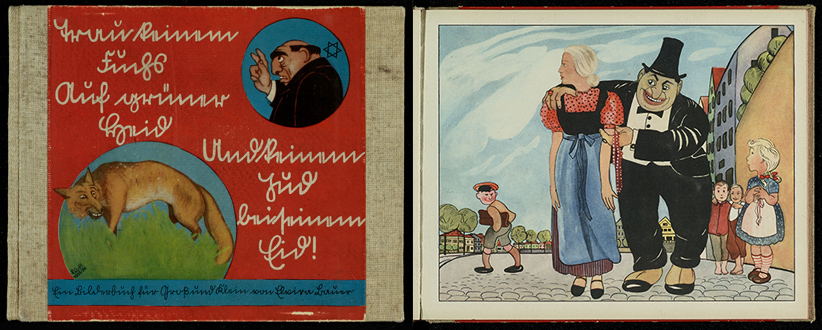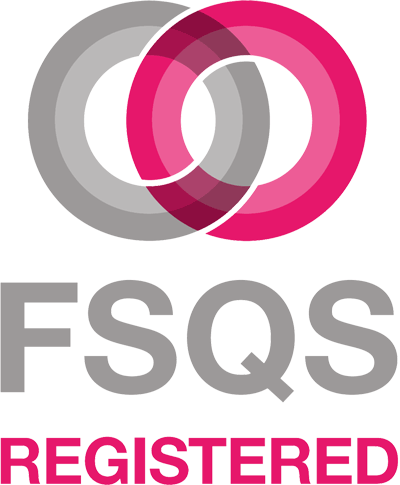When the National Holocaust Centre and Museum (based in Newark, Nottinghamshire) decided to move forward with a large scale digitisation initiative in late 2015, TownsWeb was chosen as a partner on the project.
Above image: Artists impression of the Kindertransport; item taken from the National Holocaust Centre & Museum
The mission that the National Holocaust Centre and Museum (NHCM) has dedicated itself to since its opening in 1995 is to preserve and expose the individual stories of the Holocaust and the human lives it impacted.
As part of this ongoing mission, NHCM wanted to open up access to its collections through digitisation and engage with greater audiences by publishing the digitised images online – via digital exhibitions, blog posts and other outreach activities.
So beginning in December 2015, our technicians digitised and preserved over 2000 fragile photographs, postcards and other items from the Museum’s collection
Opening access through Digitisation
Public access to NHCM’s valuable and emotive collections was limited by both the Museum’s remote location in Nottinghamshire, and by the condition of the items – many of which are too fragile to risk handling by visitors or regular removal from safe archival storage. Allowing visitors and researchers access to the records was a vital part of the Museums emphasis on increasing education and awareness.
Above: The National Holocaust Centre & Museum, Newark, Nottinghamshire.
Furthermore, the fragile physical records had very limited use in educational activities or resources. The Museum has a clear mandate to provide educational programmes, particularly for children. But these precious records, while highly educational, were too valuable to risk frequent handling physically.
The Curator at NHCM, Aneesa Riffat, identified digitising the collection and producing an online repository as a way of circumventing these difficulties. However the Museum lacked the specialist equipment needed to capture images at a suitable quality.
Following consultations with TownsWeb, the Museum identified a collection of items they believed would benefit the most from digitisation, based on their condition, their historical value and the need to have the story made available
Project Goals
- To open up digital online access to the public of Holocaust Museum materials too fragile to be viewed physically
- To reduce demand on (and deterioration of) precious physical originals by allowing digital reproductions to be used for research purposes
The Museum's collection
The team at NHCM selected over 2000 items from the Museum’s collection for digitisation. The items were chosen based on a mixture of their historical interest and significance, and their level of fragility and vulnerability to deterioration.
The materials chosen to digitise included:
- 1800 Loose photographs and postcards
- 3 Photograph albums
- 27 Bound books
- Official documentation such as 6 passports, 2 birth certificates and 14 identity cards
- 4 Physical objects such as a medal, felt flowers, a clothing label and an ornate prayer book cover
- 1 Abstract oil painting
Aneesa at NHCM chose to digitise the entire photographic collection as part of the project; both because this represented some of the most engaging material, and to take advantage of the enhancements in clarity and accessibility that digitising photographs can offer.
The NHCM photo collection contains images of the historic liberation of Bergen Belsen by British forces in 1945 and images of Auschwitz-Birkenau extermination and concentration camp. Sepia smiles paint vivid pictures of the past and reveal the humanity hidden behind such a notorious period of history.
Two of the most poignant photographic collections belonged to Holocaust survivors Ellen Rawson and Ruth David. Within these collections of photographs exist the stories of Ellen Rawson’s early family life in East Prussia and Ruth David’s upbringing in Frankfurt as Nazism swept through Europe. Both were able to get to England safely before 1939.
 |
 |
Above: Images from the Ellen Rawson photographic collection held at the National Holocaust Centre & Museum - digitised by TownsWeb Archiving
Whilst the bound books of Nazi propaganda such as the anti-Semitic “Trust No Fox” and anti-Semitic literature dressed up as fairy-tale are shockingly vivid reminders of the grim reality faced by the Jewish people during WW2.
Above: Nazi propaganda book used for indoctrination of children; item taken from the National Holocaust Centre & Museum - digitised by TownsWeb Archiving
Digitising the archive
TownsWeb digitisation consultants, specially trained in handling fragile archives, collected the materials from the Museum and transported them to our specialist digitisation studio in Northamptonshire. Due to the large volume of material, the items were collected, digitised and returned over several batches.
The digitisation was carried out by our technicians using specialist equipment capable of achieving the high capture resolution required. Using low stress, flat-bed planetary scanners with overhead DSLR cameras allowed items of all sizes to be accurately captured; whilst putting them under the bare minimum pressure.
Due to the upsetting nature of this material, all technicians were warned in advance and offered the opportunity to work on other projects if they found the images too disturbing.
Each item was captured according to archival preservation specifications: with photographs captured at 600ppi resolution; and bound volumes, documents, and other items at 300ppi. In total, 2798 images were captured during the project.
All items were captured to high-resolution TIFF image files to create a master set of preservation images, whilst a surrogate working set of smaller JPEG images was created for access and display on the web. This was especially important due to the Museums intention of publishing the archive online and creating learning resources.
TownsWeb technicians named each captured image in accordance with the object reference number assigned to the physical object by the Museum and following quality assurance checks, the Museum was provided with the full collection of digital images on a secure hard drive.
Opening access to heritage
Upon return to the Museum, the digital images were uploaded to the Museums website to allow both staff and the public to search and browse the collections online.
The digital archive organises materials categorically, allowing the public to browse general areas of interest along with a search function to find specific records or subjects. Plans are in place to improve the interface and image display as part of the Museums ongoing digital strategy.
The Museum’s long term plan is to digitise the entirety of its collections and make them accessible online, and this project represents the first stride towards achieving that goal.
Impact of the digitisation project
Talking about the impact of the project so far, Museum Curator and project leader, Aneesa Riffat, said:
“Thanks to the digitisation carried out by TownsWeb, we have been able to extend the reach of our collections, for example by using the high quality images on our website. This makes the material available for those that cannot physically get to our museum due to its rural location, but also globally for research and educational purposes.
The artefacts that have been digitised are often very fragile and cannot be displayed in a physical exhibition due to conservation issues, therefore it is great to be able to share these objects in a digital format.
The material will also be used in future educational resources as they are of much higher quality, which is important for an exploratory environment such as this. Finally, having the items digitised has also opened up new avenues of conversations with our survivors as it reinforces the benefits of preserving their stories through artefacts, and that this is helped significantly when we are able to bring the artefacts to life through digitisation.
Eventually, we would love to be able to have every item in our collection digitised so that they too can be shared in a way that is inclusive for everyone, and which gives the items and survivor stories the respect and preservation they deserve.”
View the National Holocaust Centre & Museum's digital collection
You can see the digitised collections at the National Holocaust Centre and Museum here:
https://www.nationalholocaustcentre.net/collection-menu





 USE OUR ONLINE
USE OUR ONLINE








